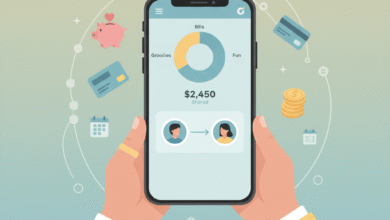
Demystifying Crypto: A Real Person’s Take on the Wild World of Digital Money
Introduction: Wait, What Even Is Crypto?
I’ll be honest. The first time someone explained Bitcoin to me, I nodded like I understood, but deep down? My brain was screaming, “Wait, so… it’s money but it’s not money?!”
Maybe you’ve felt the same. Your cousin at Thanksgiving starts bragging about Dogecoin, or a co-worker casually mentions they’re “staking ETH,” and you’re sitting there thinking, Did I miss a class in school where they explained this stuff?
That’s exactly why I decided to write this diary-style guide—to demystify crypto in plain English. No tech jargon. No confusing charts. Just real talk about what it is, how it works, and whether you should even care.
What Does “Crypto” Actually Mean?
Here’s the deal: “crypto” is short for cryptocurrency. At its core, it’s just digital money. But unlike dollars in your bank account, crypto doesn’t come from the government or a central bank.
Instead, it runs on a thing called blockchain technology. Picture a giant digital notebook that everyone can see, but nobody can erase. Every transaction gets written down, locked in, and verified by thousands of computers worldwide.
Sounds secure, right? That’s the whole point. It’s like having a family ledger, except instead of Uncle Bob sneaking in and “adjusting” his debts, the whole neighborhood has copies of the book and they’ll call him out instantly.
My First Crypto Adventure (a Cautionary Tale)
Let me tell you about the first time I bought crypto. It was 2017. Everyone and their grandma was talking about Bitcoin, so I thought, Why not? I downloaded an app, connected my debit card, and bought $50 worth.
Two weeks later, my $50 was worth $80. I felt like a financial genius. “Why didn’t I do this sooner?!” I bragged to my friends.
Then came the crash. That $80 turned into $20 practically overnight. I checked the app so much that my phone battery hated me. That was my crash course in the volatility of crypto—it can skyrocket, but it can just as easily nosedive.
Lesson learned? Crypto is exciting, but it’s not a get-rich-quick ticket.
Why Do People Even Care About Crypto?
There are a few reasons:
-
Freedom from Banks – Some folks love the idea of controlling their money without middlemen. No bank fees, no government telling you what you can or can’t do.
-
Potential for Profit – Let’s be real. People see the headlines: “Bitcoin Millionaire Buys a Lambo,” and they want in. The hype is strong.
-
Innovation – Beyond money, crypto has opened doors to new things like smart contracts, NFTs, and decentralized finance (DeFi). If those sound confusing, think of them as apps built on crypto’s backbone.
The Big Names: Bitcoin, Ethereum, and Friends
When people say “crypto,” they usually mean one of the big players:
-
Bitcoin (BTC): The OG. Created in 2009 by the mysterious Satoshi Nakamoto. Limited supply (only 21 million will ever exist). Think of it as “digital gold.”
-
Ethereum (ETH): The techie sibling. It’s not just money—it’s a whole platform for building apps and contracts.
-
Other Coins (Altcoins): Dogecoin, Solana, Cardano… some are serious projects, others are memes that got lucky.
Fun fact: I once bought Dogecoin as a joke for $5. It turned into $100 during the Elon Musk hype phase. Do I still wish I sold at the peak? Absolutely.
But… Is Crypto Safe?
Here’s the truth: Crypto is as safe as you make it.
If you buy it on a sketchy exchange or fall for a scammy Telegram message, yeah—it’s risky. But if you use trusted platforms and store your coins properly (hello, hardware wallets), your money can be pretty secure.
The real risks?
-
Volatility (your balance might look like a rollercoaster).
-
Scams (if it sounds too good to be true, it is).
-
Regulation (governments are still figuring out how to handle crypto).
Everyday Uses: Can You Actually Buy Stuff with Crypto?
Yes and no. Some companies let you pay in Bitcoin—like Overstock and some smaller online shops. Tesla flirted with the idea, then backed out. Even Starbucks lets you use crypto through certain apps.
But here’s the catch: most people don’t spend their crypto. They hold it, hoping it’ll go up in value. It’s like that one candle you bought and never lit—because “it’s too pretty to use.”
The Emotional Side of Crypto
One thing no one tells you? Crypto plays with your emotions.
You wake up at 3 AM, check the price, and suddenly you’re either on top of the world or spiraling into panic. It’s like dating someone unpredictable—thrilling, but exhausting.
That’s why experienced folks repeat the golden rule: “Only invest what you can afford to lose.”
Demystifying the Tech (Without the Tech Talk)
Let me break it down with a kitchen analogy.
-
Blockchain = Recipe Book – Everyone has the same copy. If you change something, it has to match everyone else’s copy.
-
Mining = Cooking – Computers do the “work” of solving puzzles to confirm transactions.
-
Wallet = Your Pantry – A place to store your coins. Just like pantries, some are more secure (hardware wallets) than others (hot wallets on your phone).
See? Not so scary when you think of it like baking cookies.
Should You Get Into Crypto?
Here’s my unfiltered opinion:
-
If you’re curious, sure—dip your toes in. Start small, like $20–$50. Just enough to learn how it works.
-
Don’t throw in your rent money. Please. Crypto is still new, still unpredictable.
-
Educate yourself. Read, watch YouTube explainers, maybe even listen to a podcast.
For me, crypto isn’t about trying to become a millionaire overnight. It’s about being part of a new wave of technology. Even if it never replaces the dollar, it’s shaping the future of money.
FAQs: Demystifying Crypto for Beginners
Q1: Is crypto legal in the USA?
Yes, but it’s regulated differently in each state. You can buy and sell it on major exchanges, but you’ll still owe taxes on profits. Uncle Sam always gets his cut.
Q2: Do I need a lot of money to start?
Nope. You can buy fractions of a coin. You don’t need to drop $60,000 to own Bitcoin. I started with $50, and you can too.
Q3: What’s the safest way to hold crypto?
For beginners, a trusted exchange with two-factor authentication is fine. But for long-term holders, a hardware wallet is the gold standard.
Q4: Can crypto really replace cash?
Maybe someday, but not yet. Right now, it’s more of an investment tool than an everyday currency.
Final Thoughts: My Honest Take
So, after years of dipping in and out of crypto, here’s where I stand:
Crypto is fascinating. It’s messy. It’s thrilling. It’s frustrating. And yes—it can be profitable. But it’s not magic money. It’s not guaranteed riches.
To me, crypto feels a bit like the early internet. Remember dial-up modems and clunky websites? That’s where crypto is now. In a decade, it could be everywhere—or it could fade into a niche. Nobody knows for sure.
What I do know is this: learning about it makes you part of the conversation. Whether you decide to invest or not, at least you won’t feel lost when your cousin at Thanksgiving starts bragging about their latest crypto win.
And who knows? Maybe one day you’ll be the one explaining blockchain at the dinner table.




